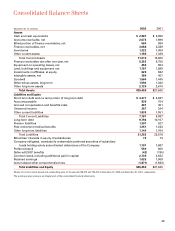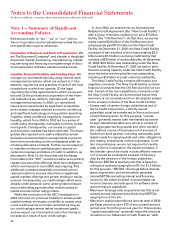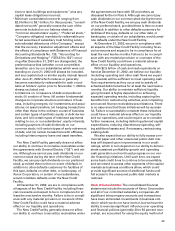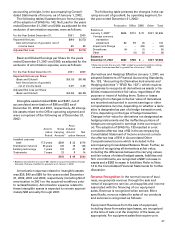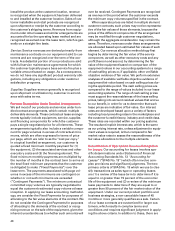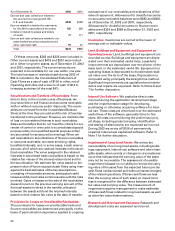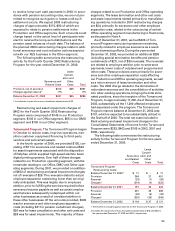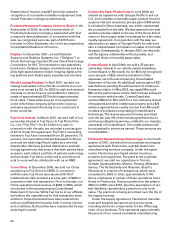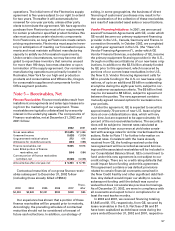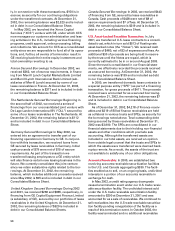Xerox 2002 Annual Report Download - page 50
Download and view the complete annual report
Please find page 50 of the 2002 Xerox annual report below. You can navigate through the pages in the report by either clicking on the pages listed below, or by using the keyword search tool below to find specific information within the annual report.
48
install the product at the customer location, revenue
is recognized when the equipment has been delivered
to and installed at the customer location. Sales of cus-
tomer installable and retail products are recognized
upon shipment or receipt by the customer according to
the customer’s shipping terms. Revenues from equip-
ment under other leases and similar arrangements are
accounted for by the operating lease method and are
recognized as earned over the lease term, which is gen-
erally on a straight-line basis.
Service: Service revenues are derived primarily from
maintenance contracts on our equipment sold to cus-
tomers and are recognized over the term of the con-
tracts. A substantial portion of our products are sold
with full service maintenance agreements for which
the customer typically pays a base service fee plus a
variable amount based on usage. As a consequence,
we do not have any significant product warranty obli-
gations, including any obligations under customer
satisfaction programs.
Supplies: Supplies revenue generally is recognized
upon shipment or utilization by customer in accord-
ance with sales terms.
Revenue Recognition Under Bundled Arrangements:
We sell most of our products and services under bun-
dled contract arrangements, which contain multiple
deliverable elements. These contractual lease arrange-
ments typically include equipment, service, supplies
and financing components for which the customer
pays a single negotiated price for all elements. These
arrangements typically also include a variable compo-
nent for page volumes in excess of contractual mini-
mums, which are often expressed in terms of price
per page, which we refer to as the “cost per copy.”
In a typical bundled arrangement, our customer is
quoted a fixed minimum monthly payment for (1)
the equipment, (2) the associated services and other
executory costs and (3) the financing element. The
fixed minimum monthly payments are multiplied by
the number of months in the contract term to arrive at
the total fixed minimum payments that the customer
is obligated to make (“Fixed Payments”) over the
lease term. The payments associated with page vol-
umes in excess of the minimums are contingent on
whether or not such minimums are exceeded
(“Contingent Payments”). The minimum contractual
committed copy volumes are typically negotiated to
equal the customer’s estimated copy volume at lease
inception. In applying our lease accounting methodol-
ogy, we consider the Fixed Payments for purposes of
allocating to the fair value elements of the contract. We
do not consider the Contingent Payments for purposes
of allocating to the elements of the contract or recog-
nizing revenue on the sale of the equipment, given the
inherent uncertainties as to whether such amounts will
ever be received. Contingent Payments are recognized
as revenue in the period when the customer exceeds
the minimum copy volumes specified in the contract.
When separate prices are listed in multiple element
customer contracts, such prices may not be representa-
tive of the fair values of those elements, because the
prices of the different components of the arrangement
may be modified through customer negotiations,
although the aggregate consideration may remain the
same. Therefore, revenues under these arrangements
are allocated based upon estimated fair values of each
element. Our revenue allocation methodology first
begins by determining the fair value of the service
component, as well as other executory costs and any
profit thereon and second, by determining the fair
value of the equipment based on comparison of the
equipment values in our accounting systems to a range
of cash selling prices or, if applicable, other verifiable
objective evidence of fair value. We perform extensive
analyses of available verifiable objective evidence of
equipment fair value based on cash selling prices dur-
ing the applicable period. The cash selling prices are
compared to the range of values included in our lease
accounting systems. The range of cash selling prices
must support the reasonableness of the lease selling
prices, taking into account residual values that accrue
to our benefit, in order for us to determine that such
lease prices are indicative of fair value. Our interest
rates are developed based upon a variety of factors
including local prevailing rates in the marketplace and
the customer’s credit history, industry and credit class.
These rates are recorded within our pricing systems.
The resultant implicit interest rate, which is the same
as our pricing interest rate, unless adjustment to equip-
ment values is required, is then compared to fair
market value rates to assess the reasonableness of the
fair value allocations to the multiple elements.
Determination of Appropriate Revenue Recognition
for Leases: Our accounting for leases involves spe-
cific determinations under Statement of Financial
Accounting Standards No. 13 “Accounting for
Leases” (“SFAS No. 13”) which often involve com-
plex provisions and significant judgments. The two
primary criteria of SFAS No. 13 which we use to clas-
sify transactions as sales-type or operating leases
are (1) a review of the lease term to determine if it is
equal to or greater than 75 percent of the economic
life of the equipment and (2) a review of the minimum
lease payments to determine if they are equal to or
greater than 90 percent of the fair market value of the
equipment. Under our current product portfolio and
business strategies, a non-cancelable lease of 45
months or more generally qualifies as a sale. Certain
of our lease contracts are customized for larger cus-
tomers, which results in complex terms and
conditions and requires significant judgment in apply-
ing the above criteria. In addition to these, there are



